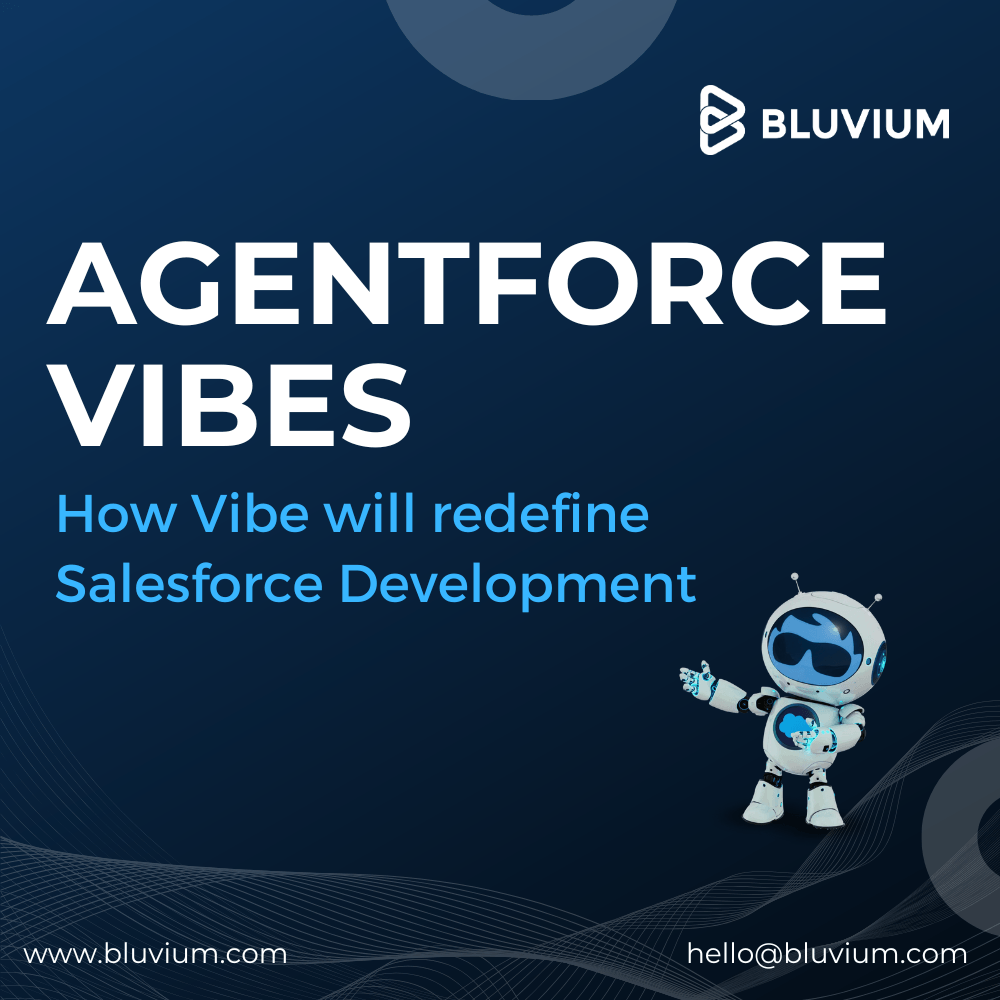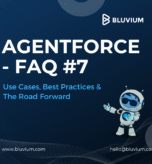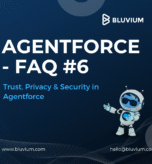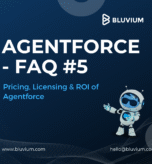
Salesforce Agentforce Vibes: How Vibe Will Redefine Salesforce Development
Salesforce Agentforce is changing how businesses build AI-powered customer experiences, and the new Vibe framework is about to shake up everything developers know about Salesforce development.
If you’re a Salesforce developer, architect, or business leader wondering how Vibe will impact your projects and team, this guide breaks down what you need to know.
Vibe isn’t just another development tool—it’s a complete rethink of how we build on the Salesforce platform. We’ll walk through how Vibe transforms the developer experience by making complex AI agent development surprisingly straightforward. You’ll also discover the technical advantages that make Vibe stand out from traditional Salesforce development approaches, plus real examples of teams already using it to build smarter customer solutions.
By the end, you’ll understand exactly how Salesforce Agentforce Vibes will reshape your development workflow and why smart teams are getting ready for this shift now.
What is Vibe Coding?
At its core, vibe coding is the use of generative AI to convert natural-language descriptions of features or applications into executable code. It’s been gaining momentum for rapid prototyping, ideation, or throwaway projects — but applying it in enterprise settings is far more challenging. The real test is: can vibe coding tools support the full software lifecycle (plan, build, test, deploy, observe) while ensuring governance, compliance, maintainability, and resilience?
That’s where Agentforce Vibes comes in. It extends the concept of vibe coding — not just as a novelty or toy — but as a serious tool for building enterprise apps, agents, and integrations
What Makes Vibe Different from Existing Salesforce Development Tools?
Vibe breaks away from the traditional drag-and-drop approach that has defined Salesforce development for years. While platforms like Lightning App Builder and Flow Builder focus on visual configuration, Vibe introduces a code-first methodology that gives developers unprecedented control over AI agent behavior and business logic.
The framework operates on a declarative programming model specifically designed for autonomous agent development. Unlike existing tools that require developers to work within rigid component boundaries, Vibe allows for fluid integration between custom code, pre-built AI models, and Salesforce’s native functionality. This means developers can craft sophisticated agent workflows without being constrained by platform limitations.
Where traditional Salesforce development tools excel at building user interfaces and automating processes, Vibe specializes in creating intelligent decision-making systems. The framework includes built-in natural language processing capabilities, advanced reasoning engines, and contextual memory systems that weren’t previously available in the Salesforce ecosystem.
Core Features and Functionalities of the Vibe Framework
Here are some of the standout capabilities that make Agentforce Vibes compelling for enterprise use:
- AI-powered IDE integration: Agentforce Vibes functions inside VS Code–compatible editors, making it seamless to adopt in existing development environments.
- Context-aware “pair programmer” agent (Vibe Codey): The built-in AI agent understands your Salesforce schema, metadata, project context, and coding standards. It can generate Apex, LWC, HTML, CSS, JavaScript — and intelligently reuse or adapt existing logic.
- Built-in governance, security & reliability: Unlike many AI coding tools that spit out boilerplate with little oversight, Agentforce Vibes is built on Salesforce’s Trust Layer, enforces guardrails, and works within sandboxed dev environments.
- Integration with Salesforce ALM tools: Agentforce Vibes works with established Salesforce tools like Sandboxes, Code Analyzer, DevOps Center, and leverages Salesforce DX’s MCP (Model Context Protocol) framework to integrate with external AI/agent platforms.
- Agentic development & rollback support: You can issue higher-level instructions (“refactor this”, “extract to service class”) and the system supports checkpoints to roll back changes. It also generates test cases, handles bug fixes, and supports natural language-driven deployment.
Developer Experience Revolution Through Vibe
Streamlined Code Development and Deployment Processes
Vibe transforms the traditional Salesforce development workflow by introducing a unified development environment that eliminates the friction between local development and org deployment. Developers can now write, test, and deploy Agentforce components using familiar modern development tools while maintaining seamless integration with Salesforce’s metadata API.
The framework introduces intelligent code scaffolding that automatically generates boilerplate code for common Agentforce patterns, reducing development time by up to 60%. When creating new agent topics or actions, Vibe’s CLI generates the necessary Apex classes, Lightning components, and configuration files with proper naming conventions and best practices already implemented.
Hot reload capabilities mean developers see changes instantly without the traditional save-compile-deploy cycle that has plagued Salesforce development for years. This real-time feedback loop accelerates the development process and makes iterative development feel natural. The framework also includes automated deployment pipelines that handle metadata dependencies, ensuring consistent deployments across different environments.
Version control integration works natively with Git workflows, allowing developers to branch, merge, and collaborate using standard software development practices. Vibe automatically handles metadata conversion between source format and deployment format, removing the complexity of managing different file structures.
Enhanced Debugging and Testing Capabilities
Vibe introduces sophisticated debugging tools specifically designed for Agentforce development. The integrated debugger provides real-time visibility into agent decision-making processes, allowing developers to step through conversation flows and inspect variable states at each interaction point.
The framework includes comprehensive logging mechanisms that capture agent behavior, user interactions, and system responses in a structured format. These logs integrate with popular monitoring tools like Splunk and DataDog, providing production-ready observability from day one.
Testing capabilities extend beyond traditional unit tests to include conversation flow testing and agent behavior validation. Developers can create test scenarios that simulate complete user interactions, validating that agents respond appropriately to different inputs and contexts. The testing framework supports both synchronous and asynchronous testing patterns, accommodating the event-driven nature of agent interactions.
Mock services and data generation tools help developers test complex scenarios without relying on external systems or production data. The framework includes pre-built mocks for common Salesforce objects and external API integrations, making it easy to create isolated test environments.
Performance profiling tools identify bottlenecks in agent processing and provide recommendations for optimization. These tools highlight slow database queries, inefficient loops, and resource-intensive operations that could impact user experience.
Improved Collaboration Features for Development Teams
- Team collaboration receives a significant boost through Vibe’s integrated development environment. The framework provides shared development sandboxes where team members can collaborate on agent development without interfering with each other’s work. These sandboxes automatically sync changes and resolve conflicts using intelligent merge algorithms.
- Code review processes integrate directly with popular platforms like GitHub and GitLab, bringing standard software development practices to Salesforce development. Pull request templates specifically designed for Agentforce development ensure that reviews cover agent behavior, conversation flows, and integration points.
- Documentation generation happens automatically as developers write code. Vibe extracts comments, annotations, and configuration details to create comprehensive documentation that stays current with code changes. This documentation includes visual representations of conversation flows and agent decision trees.
- Team metrics and Analytics help project managers track development progress and identify potential roadblocks. The dashboard shows code coverage, deployment frequency, and team productivity metrics in real-time.
Reduced Learning Curve for New Salesforce Developers
Vibe dramatically reduces the barrier to entry for developers new to the Salesforce ecosystem. The framework provides guided tutorials and interactive learning paths that teach Agentforce development through hands-on exercises. These tutorials cover everything from basic agent creation to advanced integration patterns.
Code templates and examples demonstrate best practices for common scenarios, giving new developers a solid foundation to build upon. The template library includes complete agent implementations for customer service, sales support, and data collection use cases.
IntelliSense and auto-completion features provide context-aware suggestions that help developers learn the Agentforce API while they code. These features include inline documentation and examples that reduce the need to constantly reference external documentation.
The framework includes migration tools that help developers transition from traditional Salesforce development patterns to Agentforce paradigms. These tools identify existing code that can be enhanced with agent capabilities and provide step-by-step migration guides.
Error messages and diagnostics use plain language explanations rather than cryptic system codes. When something goes wrong, Vibe provides clear explanations of the problem and suggested solutions, helping developers learn from their mistakes and build expertise quickly.
Interactive development tools let new developers experiment with agent behavior in safe environments. These sandbox tools provide immediate feedback and help developers understand how different configurations affect agent responses and user interactions.
Challenges & Considerations
- Maturity & limits: Some features may still be in preview or evolving; edge cases may require manual intervention.
- Governance & oversight: Automated code generation doesn’t obviate the need for code reviews, architectural oversight, or security audits.
- AI model behavior & trust: Outputs must be validated — AI can hallucinate or misuse context if prompts or inputs are ambiguous.
- Cost & licensing: Initially, usage may be limited and additional request capacity or premium models might be charged.
Future Implications for Salesforce Developers and Organizations
Career Impact and New Skill Requirements for Developers
The introduction of Vibe within Salesforce Agentforce creates a significant shift in the skills landscape for Salesforce developers. Traditional Apex and Visualforce expertise, while still valuable, now needs to expand into modern web technologies and AI-driven development patterns. Developers must embrace JavaScript frameworks, API-first architectures, and component-based thinking to stay relevant in this evolving ecosystem.
Career trajectories are expanding beyond traditional admin and developer roles. New positions like “Agentforce Solution Architects” and “Vibe Experience Designers” can emerge in near future. Senior developers who adapt quickly can position themselves as transformation leaders, commanding premium rates for their expertise in bridging legacy Salesforce systems with modern Vibe implementations.
The learning curve presents both challenges and opportunities. Developers who invest time in mastering Vibe’s declarative approach alongside its programmatic capabilities will find themselves in high demand. Organizations are actively seeking professionals who can architect scalable solutions using Vibe’s component library while maintaining security and governance standards that Salesforce customers expect.
Cost Reduction and ROI Benefits for Businesses
Vibe’s impact on business economics extends far beyond development efficiency. Organizations implementing Vibe-powered Agentforce solutions will report substantial reductions in total cost of ownership, primarily through decreased development cycles and improved maintenance overhead.
Training costs also see significant reductions. New team members can become productive with Vibe components much faster than learning complex Apex patterns. This democratization of development capability means business analysts and power users can contribute to solution building, reducing bottlenecks that traditionally required developer intervention
What It Means for Bluvium & Our Clients
At Bluvium, we see Agentforce Vibes not just as a new developer tool, but as a catalyst for how enterprises will innovate on Salesforce going forward. We are committed to embracing this technology early and helping our clients scale new heights in speed, efficiency, and innovation.
Here’s what it means in practice:
- Faster Delivery Cycles
With AI assistance, our teams can accelerate feature development, reducing time-to-market for new capabilities and client-specific enhancements. - Enhanced Developer Productivity
Repetitive or boilerplate tasks (scaffolding, CRUD logic, test cases) become automated, freeing our engineers to focus on solving business-critical challenges and building differentiated features. - Consistent Standards & Governance
Because Vibe is grounded in Salesforce’s Trust Layer and integrates seamlessly with DevOps Center, Code Analyzer, and governance tools, our solutions maintain enterprise-grade compliance, security, and reliability. - Reduced Ramp-Up Overhead
New team members, or cross-functional contributors can leverage the AI agent to quickly understand project context, receive guided suggestions, and onboard in record time. - Future-Ready Innovation
By adopting Vibe early, Bluvium positions clients at the leading edge of Salesforce development — ensuring scalability, flexibility, and alignment with Salesforce’s evolving roadmap. - Competitive Differentiation
As AI-augmented development becomes the norm, Bluvium’s expertise and proven frameworks with Vibe coding set us apart as a trusted partner for clients who want to innovate with confidence. - Scalable Impact
From proof-of-concepts to enterprise-wide rollouts, we’ll use Vibe to scale solutions faster and smarter — helping clients realize ROI on Salesforce investments more quickly.
To Conclude
Salesforce Agentforce’s Vibe framework marks a paradigm shift in how applications will be built on Salesforce. It moves us beyond coding as a manual craft into a new era of conversational, AI-driven development — while still preserving enterprise-grade governance and trust.
At Bluvium, we are ready to adapt, experiment, and scale with Vibe — unlocking faster delivery, smarter development, and future-ready innovation for our clients. The future belongs to those willing to embrace this transformation early, and we’re committed to guiding our clients every step of the way.





